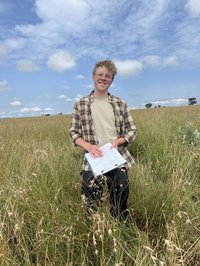The effects of grazing systems on grass composition and biomass availability in Mara North Conservancy, Masai Mara

Msc. Student: Mads Gammelgaard
Program: Msc. Department of Biology, Aarhus University
Supervisor: Professor Jens-Christian Svenning and Assistant Professor Robert Buitenwerf
Period: february - april 2024
Objective
The aim of this study is to examine the effect of different grazing systems on the species composition of grass, available biomass and structure of grasslands in a savannah ecosystem in Mara North Conservancy in Masai Mara, Kenya. As different types of grass and different grass heights are preferred by different wild herbivores and cattle, knowledge on how these crucial factors are affected by different grazing systems are essential for making conservation decisions. Specifically, I will compare the species composition, structural indicators and grass biomass in 3 different systems: rotational grazing system, shoat grazed areas and areas grazed only by wildlife. Investigating these systems I aim to uncover how a grassland system responds to a variety of grazing practices from livestock dominated to wildlife dominated as well as a third possibly sustainable method of coexistence between wildlife and the local populace’s livestock through rotational grazing.
With extensive field samples of biomass I wish to create a predictive model using remote sensing data to predict biomass availability in space and time. Doing this would make it possible to investigate potential trends in biomass availability for grazing animals on the savannah as well as the distribution of tall grass habitats.
Background
As a method of conserving the pastoralist culture of the Masai people and to support the unique wildlife of Masai Mara, Mara North Conservancy (MNC) was created. The conservancy land is owned by the local people, but instead of establishing agriculture, fencing and other landscape barriers, the conservancy instead keeps the land open for nature to thrive. Doing this has allowed a unique ecosystem that maintains high densities of the world’s last remaining megafauna. MNC has implemented a rotational grazing system in which cattle is rotated periodically between sectors, eating tall grass which allows for regrowth and thus food availability for many of the savannahs wild herbivores. This system also allows for refuges of crucial resting periods in which there is no cattle and allows for the return of wildlife. However, while the effect of rotational grazing on the behaviour of wildlife is previously studied, the effect on foundational vegetative level is understudied and poorly understood. As grass is the most crucial food for wildlife on the savannah, as well as creating different habitats for herbivores and predators, the exact effects of this rotational grazing system on grass composition and biomass should be investigated further.
Method
The study will utilize plots in which I will investigate 1) grass height using a pasture disc meter in four 20x20 meter subplots, 2) in two 5.64 radius subplot circles I will assess structural factors such as the cover of shrubs, forbs and graminoids and 3) the species composition of grasses will be assessed within the circle subplots. For the predictive remote sensing model I will use the grass height subplots in conjunction with MODIS data to predict grass height in space and time.
Fieldwork
Data collection will be done in collaboration with the Masai Mara Science and Development Initiative and will be performed in MNC using the Karen Blixen Camp for accommodation in their researcher facilities
. The fieldwork will stretch from February to April